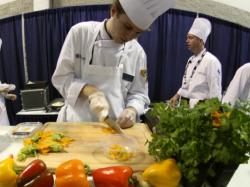Students Rise To The Challenge At The New York Produce Show
December 11, 2015 | 4 min to read

“I believe the children are our future, teach them well and let them lead the way.” This line from the popular Whitney Houston tune “Greatest Love of All” is apropos to a number of things and one that is taken to heart in the foodservice industry. After all, the future chefs of tomorrow aren’t going to be great just by reading cookbooks; they need to be educated on the business and shown first-hand how to create culinary masterpieces.
That’s why the New York Produce Show and Conference devotes time each year to holding a Culinary Innovation Station, featuring student chefs from some of the top culinary schools foraging produce from exhibitor booths to create fantastic dishes to share with attendees and to impress culinary judges.
The overall competition is student-driven from concepts, to foraging the tradeshow floor, to brainstorming and execution. This year, the students were tasked with making quesadillas, and judging how quickly they were gobbled up at the “Central Park’s Culinary Concert in the Park,” there were plenty of A+ scores given.
Among the ingredients provided to the students for the competition were apples by NY Apple County; mushrooms by Phillips Mushrooms; microgreens by Fresh Origins; a variety of spices and pastes by Gourmet Gardens; Asian pears by I Love Produce; five-star premium greens and herbs by Graff Farms; shallots, onions and garlic by Christopher Ranch; and Cape Gooseberries by Sun Belle.
The Leaders Speak
One of the culinary leaders for the students was John Abels, chef and lead instructor for Le Cordon Bleu, Chicago, who notes that the student competition has become an integral part of the overall experience at the New York Produce Show and Conference, and he’s thankful to have been apart of it since its inception in 2010.
“It’s a phenomenal opportunity for students to practice their techniques and critical thinking skills,” he said. “The sheer amount of learning that occurs during this show is immeasurable. Students get a larger view of what it takes for those delicious fruits and vegetables to get to our preparation tables. They get experience in talking to vendors, learning from other professional chefs, and practicing what they learned. I, as an instructor, have grown in my cooking and instructional style; I unconsciously teach more veg-centric.”
Watching the students this year, Abels was most impressed by the students’ ability to have conversations with exhibitors about their product, and build strong connections.
“It was to the point that the exhibiting companies came to our stage and wanted to see how their product was being utilized in recipes,” he said. “This is a huge opportunity for exhibiting companies to see how the end user (chefs in many cases) can utilize their products.”
Another industry veteran serving as a culinary leader was Douglas Stuchel, associate professor and foodservice management faculty advisor for Johnson & Wales University, who also returned for his fifth year in the role.
“The focus for me isn’t the competition but the ability for the JWU students to network and experience a part of the industry they are unfamiliar with,” he said. “Now more than ever, we are an industry of relationships, from grower, to shipper, to purveyor, to chef. Events like these expand the students’ education into the foodservice industry on many levels. An event like this, although only a couple of days long, is often more valuable than weeks in the classroom.”
Stuchel feels that future culinary experts will be more focused on the environment and sourcing food products from companies that are good environmental stewards, and the show gave the students a chance to seek that out. He adds that the show has always been a great opportunity for the students, but this year was even greater.
“I am impressed with how quick the show has grown during the past five years and the increased participation in the Ideation Fresh portion of the conference,” he said. “Also, [I’m impressed with] the caliber of celebrity judges and well-known industry professionals judging the student competition and participation in Ideation Fresh panel discussions.”
Judging The Competition
John B. Coker, executive vice president for corporate strategy and brand development for AVI Fresh, feels the teams were very engaged and worked hard to produce multiple courses on a fast timeline.
“This event focuses on the creative use of fresh produce, which is becoming more prevalent in the American diet — and should continue to increase with a new generation of chefs focused on produce in creative and inventive ways — as we look to increase consumption for all Americans to understand the significance in our diets and health,” he said. “I was impressed by the students’ focus and determination to be creative and deliver fantastic dishes.”
Shawn LaPean, executive director of Cal Dining-UC, Berkeley, was impressed with the students’ professionalism, and wished they had more of a meal plan to work with rather than the “traditional quesadilla.” He said the experience was a wonderful opportunity for them to plant their foot in the industry.
“More 17 to 25 year olds are modeling better eating and nutrition behaviors with every passing year,” he said. “Having 17- to 30-year-old students cooking allows those students to become exposed to more plant-forward thinking that may change the path they utilize in their future careers. This event affords them opportunities to learn from others — some of the best in our industry.”
Other judges taking part in the event included Gene Harris, director of supplier diversity at Denny’s; Susan Renke, director of sponsorship for Women Chefs & Restaurants; Terri Moreman, associate director food & nutrition services at the United States Olympic Committee; Laki Trantos, operations manager for the Cheesecake Factory; and Justin Timineri, a chef and international culinary ambassador representing the state of Florida.
Source: PerishableNews.com
